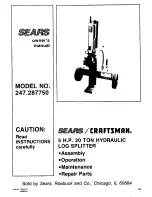
Summary of Important Safety Information for Operation
32
Safety During Inspection/Maintenance
Always inspect your log splitter before each use, and repair as needed, to keep it in safe working condition:
Engine off.
Always make sure the engine is off before cleaning, repairing or adjusting the splitter, except as
recommended by the manufacturer.
Engine debris.
Debris on a hot engine can be a fire hazard. With the engine off, clean debris and chaff from engine
cylinder head, cylinder head fins, blower housing rotating screen, and muffler areas. Avoid contact with hot
muffler
.
Other debris.
Debris on moving parts can cause excess wear. With the splitter engine off, clear debris from
moving parts.
Fuel tank / lines.
Before each use, check fuel tank and fuel lines for leaks. Any fuel leak is a fire hazard. Fix any
fuel leaks before starting engine.
Mechanical parts.
Check to be sure that all nuts and bolts are tight to make sure the log splitter is in safe working
condition.
Hydraulic system.
Check the hydraulic system (hoses, tubing, clamps/fittings, pump, and cylinder) carefully
before each use. Do not operate the log splitter with frayed, kinked, cracked or damaged hydraulic hoses, fittings, or
tubing, or if oily residue is observed on any of the components. High fluid pressures and temperatures are
developed in the log splitter. Hydraulic fluid escaping through a pin hole sized opening can burn or puncture skin,
resulting in wounds that could cause blood poisoning, infection, disability, gangrene, amputation, or death.
Therefore, the following instructions should be heeded at all times when inspecting or servicing the hydraulic
components of the log splitter:
o
Do not remove the hydraulic oil dipstick when the engine is running. Hot oil can escape causing severe
burns. Allow log splitter to cool completely before removing hydraulic oil dipstick.
o
Do not adjust the pressure setting of the pump or valve.
o
Do not check for leaks with your hand. Leaks can be located by holding a piece of cardboard or wood (at
least two feet long) with your hand at one end and passing the other end over the suspected area (wear eye
protection). Look for discoloration of the cardboard or wood.
o
Stop the engine, disconnect the spark plug, and move all control valve handles back and forth to relieve
pressure before changing or adjusting hydraulic system components such as hoses, tubing, fittings or
other components.
o
If injured by escaping fluid, no matter how small the wound is, see a doctor at once. A typical injection
injury may be a small puncture wound that does not look serious. However, severe infection or reaction
can result if proper medical treatment is not administered immediately by a doctor who is familiar with
injection injuries.
Spark arrestor muffler
. If the engine is equipped with a spark arrestor muffler, clean and inspect it regularly
(follow manufacturer's service instructions). Replace if damaged.
Tires
. Be sure tires are fully inflated and in good repair before towing the splitter. When adding air to tires, do not
over-inflate -- serious injury could occur if tire explodes.
Guards / shields.
Make sure all guards and shields are replaced after servicing the log splitter.
Replacement parts.
If a part needs replacement, only use parts that meet the manufacturer's specifications.
Replacement parts that do not meet specifications may result in a safety hazard or poor operation of the log splitter.
Safety During Fueling
Gasoline is highly flammable and explosive.
You can be burned or seriously injured when handling fuel. Use
extreme care when handling gasoline:
Fuel outdoors
. Fill fuel tank outdoors – never indoors. Gasoline vapors can ignite if they collect inside an
enclosure. Explosion can result.
Use approved container
. Never pump fuel directly into engine at gas station. Static charge can build and ignite
fuel. Use an UL approved fuel container to transfer gas to the engine.
Running / hot engine
. A running engine is hot enough to ignite fuel. Never add fuel or remove gas cap if engine is
running or still hot. Stop the engine and allow to cool at least two minutes before adding fuel.
Heat / flames / sparks
. Stay away from sources of heat, flame, or sparks while adding fuel.






























